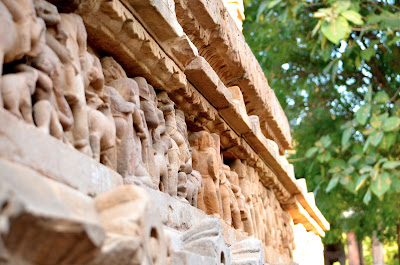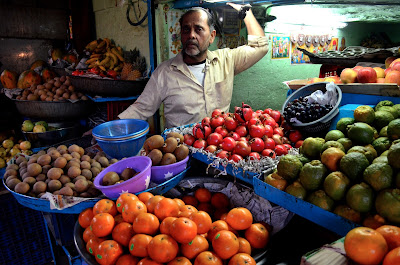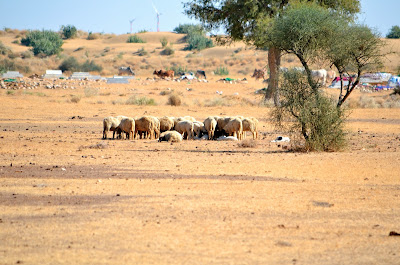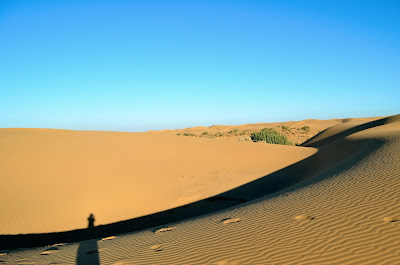I started off this year writing about my lack of routine in Benares, but if there was ever a time to say that I really truly have fallen in to a good routine, it would be now. Even though I felt comfortable and settled in Benares very soon after arriving here, looking back, I'm quite sure that all the time between my arrival in the end of September and our departure for Rajasthan in December was just a very long, very subtle period of acclimatization. It was only after arriving back from Rajasthan at the end of December and finding my way back in to a routine after two weeks away that I could really say, I live here. I live in Benares. This is my life. That, not simple repetition of a series of acts, is what I mean by a routine. Benares, at the moment, and for the past month and a half, hasn't been "the place where I am living for seven months", it is, quite simply, the place I live. There are no qualifiers.
Of course, soon, there will be. The end of my time in Benares doesn't feel too far off and when it's nearly here, qualifiers will start mounting. My Benares will metamorphose into "the place I lived for seven months." It will be the place I spent my gap year. The place I miss. The place I have endless potent memories from. But I won't be able to call it the place I live.
But, I haven't gotten there yet. I won't get ahead of myself. Right now, my life is saturated by this city. I couldn't imagine being anywhere else. We went to Delhi last weekend and even Delhi felt like a strange, distant land. It was enough unlike Benares that we had flashes of being back in America, a sense that we were about to get on an airplane and go back home. And for anyone who hasn't been to Delhi, it may, in some places, bear resemblences to the United States, but it is definitely India. And yet, for us, imagining a life anywhere other than Benares was shocking.
Life in Benares has taken on a quality of "obvious-ness". Let me explain. All throughout elementary school and high school - and this will be true in the future as well - it was obvious that my life was made up of five day school weeks and then a weekend and then another five day school week and so on and so forth. In the same way that I described something in a previous blog post, this too is something so obvious that it is even beyond being a fact to be known or unknown. It's just the way things are.
Ever since I got here, there was never any question that my routine would involve five day work weeks at Guria rotated around weekends, but now that routine is as obvious as a twelve year-old kid in America expecting to go to school. What else would I be doing? Working at Guria to is so obvious to me that's it's beyond being a factual reality. There just is no other reality. And that's when I realized I have a routine. I live here.
Ironically, in the process of cementing a routine, I've spent more time exploring and expanding what I do here. Last month, I started taking Urdu classes with the wonderfully friendly, intelligent, patient Salmanji (for anyone who read my Bakri Eid blog post, it was his home in which we saw the goat slaughter). Urdu is the official language of Pakistan and is spoken by most-all of the Muslim community in India. Grammatically and structurally, Urdu is the same as Hindi. Verbs, pronouns, and prepositions and other very technical parts of speech are all the same as Hindi. It's in nouns, adjectives, and adverbs - mostly - where the languages differ. Even that is a bit contentious because "modern" Hindi is really a mix of pure Hindi and a great deal of Urdu loan words (and then words that are in both languages and I couldn't tell you which they came from)...
That being said, I started off in Urdu by learning to read and write the script. The script is almost the same as Arabic, but not quite. As you can see, Urdu is an eclectic mix of influences ranging from India to the Near East: quasi-Arabic script, Arabic and Farsi loan words, and a Hindi base, all mixed in with a smattering of its own vocabulary. But it's a bit like learning a million different things in one, which I love. The script is beautiful - and difficult - and I love writing it and the feeling of deciphering a page full of dots, loops and squiggles. I've also been able to jump straight into reading short stories in Urdu because of my knowledge of Hindi, which has been a lot of fun; it's hard to tell if I'm learning more Urdu or Hindi, but I guess the truth is that I'm learning both at the same time, and from a really wonderful teacher, so what more could I ask for?
In fact, just yesterday, we went on a tour of several mosques and Sufi shrines around Beneres with Salmanji. He showed us the oldest mosque in Benares, apparently 1000 years old, but only unearthed again 100 years ago. We also saw two Sufi shrines, the burial places of famous Muslim saints from Benares. Sufism is a rather contested sect of Islam because many people don't agree that you can or should pray to a dead saint to pray to God on your behalf. But it is certainly an active sect. The Sufi shrines here in Benares attract crowds of supplicants, Muslim and Hindu alike. People who are believed to be possesed by the devil are often brought to Sufi shrines for healing. The shrines we went to were insence-laden and crowded with people bringing gifts to show their respect to the deseaced saint. Outside the shrines were groups of men playing instruments and singing traditional poetic Sufi music.
Although Benares is certainly an overwhelmingly Hindu city, between the calls to prayer that sometimes wake me up early in the morning, the minarets of mosques that inconspicuously dot the city, the popular Sufi shrines, and the very obvious presence of Muslim festivals Islam is certainly an important part of the thick religious fabric of the city. Last month, the Muslim festival Mawlid al-Nabi - the Prophet Mohammed's birthday - took place. All around the Muslim quarter and the surrounding areas, the streets buzzed with a celebratory air. Groups of men were out on the streets in their best white kurtas, drinking chai and eating sweets from stands that had popped up just for the occasion. Kids ran around with crescent moon flags and buildings were decorated with lights and strands of green confetti. Huge masses of men surrounded trucks playing traditional Muslim music. That night, in search of an "Urdu poetry festival" that was supposedly happening, we wandered over to the Muslim section of town, to find crowded, glowing alleyways full of food stands and people in their best dress, standing in groups and singing Urdu poetry. There were endless twinkle-lights and a massive, glittery, colorful image of a mosque. Beautiful, yearning melodies meandered down the alleyways from groups of poetry-reciting men.
Never going too long without one of its own festivals, right around Mawlid al-Nabi, Hindus celebrated Makar Sankrati, also known as Kitcheri, or, to us foreigners, "the kite festival." How a harvest festival with astrological significance became about flying kites, I'm not quite sure, but it's quite true that nearly every single person in Benares flies a kite on Makar Sankrati. To say the sun is blotted out by a skyful of kites would, I admit, be an exaggeration, but there's hardly a better way to put it. Look up at the sky on Makar Sankrati and kites are everywhere, coming from every rooftop in Benares and from all along the banks of the Ganga. People fly kite after kite, quickly casting out a new one after the previous kite is inevitably cut down by another kite's ubiquitous glass kite string. While most Hindu festivals seem to be focused on the night-time, Makar Sankrati is a day full of fun and celebration, rooftops and wind and kites and sun. What's not to love?
Bring on festivals, day trips, schedules changes, whatever may come, but at the moment, nothing can shake my routine here. Those are all part of it. New exploration, new sights, new languages - it's all part of Benares, all part of my life.
[Photos to come]
Of course, soon, there will be. The end of my time in Benares doesn't feel too far off and when it's nearly here, qualifiers will start mounting. My Benares will metamorphose into "the place I lived for seven months." It will be the place I spent my gap year. The place I miss. The place I have endless potent memories from. But I won't be able to call it the place I live.
But, I haven't gotten there yet. I won't get ahead of myself. Right now, my life is saturated by this city. I couldn't imagine being anywhere else. We went to Delhi last weekend and even Delhi felt like a strange, distant land. It was enough unlike Benares that we had flashes of being back in America, a sense that we were about to get on an airplane and go back home. And for anyone who hasn't been to Delhi, it may, in some places, bear resemblences to the United States, but it is definitely India. And yet, for us, imagining a life anywhere other than Benares was shocking.
Life in Benares has taken on a quality of "obvious-ness". Let me explain. All throughout elementary school and high school - and this will be true in the future as well - it was obvious that my life was made up of five day school weeks and then a weekend and then another five day school week and so on and so forth. In the same way that I described something in a previous blog post, this too is something so obvious that it is even beyond being a fact to be known or unknown. It's just the way things are.
Ever since I got here, there was never any question that my routine would involve five day work weeks at Guria rotated around weekends, but now that routine is as obvious as a twelve year-old kid in America expecting to go to school. What else would I be doing? Working at Guria to is so obvious to me that's it's beyond being a factual reality. There just is no other reality. And that's when I realized I have a routine. I live here.
Ironically, in the process of cementing a routine, I've spent more time exploring and expanding what I do here. Last month, I started taking Urdu classes with the wonderfully friendly, intelligent, patient Salmanji (for anyone who read my Bakri Eid blog post, it was his home in which we saw the goat slaughter). Urdu is the official language of Pakistan and is spoken by most-all of the Muslim community in India. Grammatically and structurally, Urdu is the same as Hindi. Verbs, pronouns, and prepositions and other very technical parts of speech are all the same as Hindi. It's in nouns, adjectives, and adverbs - mostly - where the languages differ. Even that is a bit contentious because "modern" Hindi is really a mix of pure Hindi and a great deal of Urdu loan words (and then words that are in both languages and I couldn't tell you which they came from)...
That being said, I started off in Urdu by learning to read and write the script. The script is almost the same as Arabic, but not quite. As you can see, Urdu is an eclectic mix of influences ranging from India to the Near East: quasi-Arabic script, Arabic and Farsi loan words, and a Hindi base, all mixed in with a smattering of its own vocabulary. But it's a bit like learning a million different things in one, which I love. The script is beautiful - and difficult - and I love writing it and the feeling of deciphering a page full of dots, loops and squiggles. I've also been able to jump straight into reading short stories in Urdu because of my knowledge of Hindi, which has been a lot of fun; it's hard to tell if I'm learning more Urdu or Hindi, but I guess the truth is that I'm learning both at the same time, and from a really wonderful teacher, so what more could I ask for?
In fact, just yesterday, we went on a tour of several mosques and Sufi shrines around Beneres with Salmanji. He showed us the oldest mosque in Benares, apparently 1000 years old, but only unearthed again 100 years ago. We also saw two Sufi shrines, the burial places of famous Muslim saints from Benares. Sufism is a rather contested sect of Islam because many people don't agree that you can or should pray to a dead saint to pray to God on your behalf. But it is certainly an active sect. The Sufi shrines here in Benares attract crowds of supplicants, Muslim and Hindu alike. People who are believed to be possesed by the devil are often brought to Sufi shrines for healing. The shrines we went to were insence-laden and crowded with people bringing gifts to show their respect to the deseaced saint. Outside the shrines were groups of men playing instruments and singing traditional poetic Sufi music.
Although Benares is certainly an overwhelmingly Hindu city, between the calls to prayer that sometimes wake me up early in the morning, the minarets of mosques that inconspicuously dot the city, the popular Sufi shrines, and the very obvious presence of Muslim festivals Islam is certainly an important part of the thick religious fabric of the city. Last month, the Muslim festival Mawlid al-Nabi - the Prophet Mohammed's birthday - took place. All around the Muslim quarter and the surrounding areas, the streets buzzed with a celebratory air. Groups of men were out on the streets in their best white kurtas, drinking chai and eating sweets from stands that had popped up just for the occasion. Kids ran around with crescent moon flags and buildings were decorated with lights and strands of green confetti. Huge masses of men surrounded trucks playing traditional Muslim music. That night, in search of an "Urdu poetry festival" that was supposedly happening, we wandered over to the Muslim section of town, to find crowded, glowing alleyways full of food stands and people in their best dress, standing in groups and singing Urdu poetry. There were endless twinkle-lights and a massive, glittery, colorful image of a mosque. Beautiful, yearning melodies meandered down the alleyways from groups of poetry-reciting men.
Never going too long without one of its own festivals, right around Mawlid al-Nabi, Hindus celebrated Makar Sankrati, also known as Kitcheri, or, to us foreigners, "the kite festival." How a harvest festival with astrological significance became about flying kites, I'm not quite sure, but it's quite true that nearly every single person in Benares flies a kite on Makar Sankrati. To say the sun is blotted out by a skyful of kites would, I admit, be an exaggeration, but there's hardly a better way to put it. Look up at the sky on Makar Sankrati and kites are everywhere, coming from every rooftop in Benares and from all along the banks of the Ganga. People fly kite after kite, quickly casting out a new one after the previous kite is inevitably cut down by another kite's ubiquitous glass kite string. While most Hindu festivals seem to be focused on the night-time, Makar Sankrati is a day full of fun and celebration, rooftops and wind and kites and sun. What's not to love?
Bring on festivals, day trips, schedules changes, whatever may come, but at the moment, nothing can shake my routine here. Those are all part of it. New exploration, new sights, new languages - it's all part of Benares, all part of my life.
[Photos to come]












































